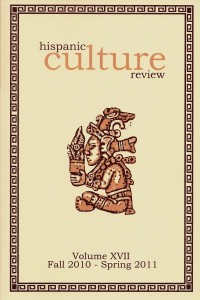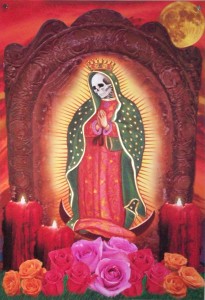 The editorial team of Hispanic Culture Review is pleased to announce that the Fall 2010-Spring 2011 volume of the bilingual journal is available starting today in George Mason University’s (GMU) Student Media office. The academic magazine is free for GMU’s students. Readers can purchase the journal for $7 by writing to hcr@gmu.edu or hcr.gmu@gmail.com.
The editorial team of Hispanic Culture Review is pleased to announce that the Fall 2010-Spring 2011 volume of the bilingual journal is available starting today in George Mason University’s (GMU) Student Media office. The academic magazine is free for GMU’s students. Readers can purchase the journal for $7 by writing to hcr@gmu.edu or hcr.gmu@gmail.com.
Subscriptions orders can also be addressed to:
Hispanic Culture Review
Student Media Office
The Hub, Room 1232
4400 University Dr., MS 2C5
Fairfax, Virginia 22030
We want to thank all the authors that contributed with a variety of poems and essays for the celebration of our twentieth anniversary.
The Fall 2010-Spring 2011 volume features:
POETRY
Homenaje a niños uruguayos
Ana M. Alvarado Hernández
George Mason University, Virginia
Rodrigo y Carmen G. quemados vivos
Ana M. Alvarado Hernández
George Mason University, Virginia
LAbor
Daniel Aristi
Belgium
1968
Melissa Castillo-Garsow
Fordham University, New York
De la simple existencia
Pedro Gandía
Spain
Poiesis
Pedro Gandía
Spain
Too late to contemplate rebirth
Paula Hayes Vasquez
Strayer University, Tennessee
Encontrémonos
Gilberto Hernández
Portugal
El grito
Matilde Humar Brezauscek
Chile
Segunda Carta a Eugenio María de Hostos
Mayra Vargas-Rodríguez
University of Puerto Rico, Río Piedras
NARRATIVE
The last of the great wetback poets
Fernando A. Flores
Texas
ESSAYS
Expresiones de la marginalidad: de las novelas picarescas a
Barrio de Fernando León de Aranoa
Mónica Camazón Mediavilla
George Mason University, Virginia
El sujeto fronterizo en La frontera de cristal de Carlos
Fuentes
Miguel Santos González
George Mason University, Virginia
Paradigmas del “performance” gastronómico en “Marina y
su olor” de Mayra Santos-Febres
María Inés Ortiz Medina
University of Cincinnati, Ohio


